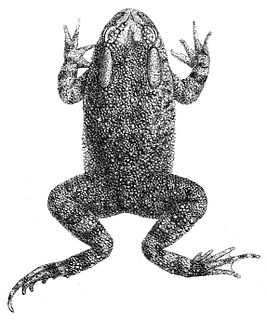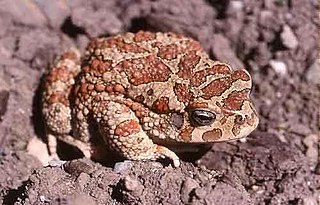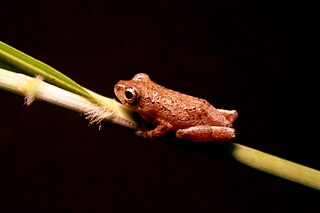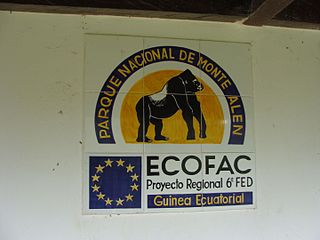Arthroleptis taeniatus is a species of frog in the family Arthroleptidae. It is found in southern Cameroon, southwestern Central African Republic, Equatorial Guinea, Gabon, western Democratic Republic of the Congo, and probably Republic of the Congo. Its natural habitats are shallow marshes in forest. It can be locally threatened by habitat loss. It is common in parts of its range.

Cardioglossa leucomystax is a species of frog in the family Arthroleptidae. It is found in large parts of Central Africa, extending into south-easternmost West Africa (Nigeria). The type locality is Cap Saint Jean in Equatorial Guinea. Populations from the Upper Guinean Forests of West Africa between Ghana and Sierra Leone previously allocated to this species were in 2008 described as a new species, Cardioglossa occidentalis. Common name silver long-fingered frog has been coined for Cardioglossa leucomystax.

Scotobleps is a monotypic frog genus in the family Arthroleptidae; its sole species is Scotobleps gabonicus, sometimes known as the Gaboon forest frog. It is found in eastern Nigeria, western Democratic Republic of the Congo, western and southwestern Cameroon, Equatorial Guinea, and western Gabon; it is presumed to occur in the western Republic of the Congo and in the Cabinda Enclave of Angola.

Sclerophrys blanfordii is a species of toad in the family Bufonidae. It is found in northeastern Ethiopia, northern Somalia, Djibouti, and Eritrea. The specific name blanfordii honours William Thomas Blandford, a British geologist and zoologist. Common names Blanford's toad and Ethiopia toad have been coined for it, the latter might specifically refer to the now-synonymized Bufo sibiliai.

Sclerophrys funerea is a species of toad in the family Bufonidae. It is found in west-central Africa, from Gabon, Republic of the Congo, and Angola eastward through the Democratic Republic of the Congo to Uganda, Rwanda, and Burundi. Its common names are Angola toad or somber toad.

The African common toad or guttural toad is a species of toad in the family Bufonidae. It is found in Angola, Botswana, Democratic Republic of the Congo, Kenya, Lesotho, Malawi, Mauritius, Mozambique, Namibia, Réunion, Somalia, South Africa, Ethiopia, Swaziland, Tanzania, Zambia, and Zimbabwe. Its natural habitats are subtropical or tropical dry forest, subtropical or tropical moist lowland forest, subtropical or tropical moist montane forest, dry savanna, moist savanna, temperate shrubland, subtropical or tropical dry shrubland, subtropical or tropical moist shrubland, subtropical or tropical dry lowland grassland, subtropical or tropical seasonally wet or flooded lowland grassland, subtropical or tropical high-altitude grassland, intermittent rivers, freshwater lakes, intermittent freshwater lakes, freshwater marshes, intermittent freshwater marshes, arable land, pastureland, rural gardens, urban areas, heavily degraded former forest, ponds, and canals and ditches.
Sclerophrys kisoloensis is a species of toad in the family Bufonidae. It is found in southwestern Kenya, Uganda, Rwanda, eastern Democratic Republic of the Congo, northeastern Zambia, western Tanzania, and northern Malawi. It probably also occurs in Burundi. Common names Kisolo toad and montane golden toad have been coined for it.

The Berber toad, also known as Mauritanian toad, Moroccan toad, pantherine toad or Moorish toad, is a species of toad in the family Bufonidae, which is found in north-western Africa, with an introduced population in southern Spain.

The African tree toad is a species of toad in the family Bufonidae. It is found in the West and Central Africa from southwestern Nigeria through Cameroon to Equatorial Guinea, Gabon, and northeastern Democratic Republic of the Congo.
The Bates' tree toad is a species of toad in the family Bufonidae. It is recorded in an area running from southern Cameroon to southwestern Gabon through southwestern Central African Republic to northeastern Democratic Republic of the Congo; it presumably occurs in Equatorial Guinea and Congo, and perhaps in Nigeria, but has not yet been recorded there. Its common and specific names commemorate George Latimer Bates (1863–1940), an American naturalist who traveled in West Africa.

Hyperolius tuberculatus is a species of frog in the family Hyperoliidae. Its common name is rainforest reed frog. It ranges from the southeastern Nigeria to the Central Africa in Cameroon, western Central African Republic, Equatorial Guinea, Gabon, Republic of the Congo, and Democratic Republic of the Congo. It is also likely to occur in the Cabinda enclave of Angola.

The Gaboon forest tree frog, Leptopelis aubryi, is a species of frog in the family Arthroleptidae. It is found in southeastern Nigeria, Cameroon, Central African Republic, Equatorial Guinea, Gabon, Republic of the Congo, western and northern Democratic Republic of the Congo, and the Cabinda Enclave of Angola.
Leptopelis boulengeri is a species of frog in the family Arthroleptidae. It is found in southeastern Nigeria, southern Cameroon, Equatorial Guinea, Gabon, Republic of the Congo, and western Democratic Republic of the Congo. It is expected to be found in the Central African Republic and the Cabinda Enclave of Angola. Common name Victoria forest treefrog has been coined for it, apparently in reference to its type locality, "Victoria, Kamerun", now known as Limbe.

Leptopelis calcaratus is a species of frog in the family Arthroleptidae. It is found in southeastern Nigeria, Cameroon, the southwestern Central African Republic, Equatorial Guinea, Gabon, the Republic of the Congo, and the Democratic Republic of the Congo. Common name Efulen forest treefrog has been coined for it.
Leptopelis christyi, also known as the Christy's tree frog or Christy's forest treefrog, is a species of frog in the family Arthroleptidae. It is known with confidence from eastern and northeastern Democratic Republic of Congo, southern and western Uganda, and northwestern Tanzania. It is likely to occur in Burundi and Rwanda, possibly ranging further in East Africa. There is an isolated population in Cameroon and Gabon that might represent a distinct species. The specific name christyi honours Dr. Cuthbert Christy, a British army doctor who collected the holotype.
Leptopelis millsoni is a species of frog in the family Arthroleptidae. It is found in southeastern Nigeria, Cameroon, the Central African Republic, Equatorial Guinea, Gabon, the Republic of the Congo, and the eastern Democratic Republic of the Congo. Common name Niger forest treefrog has been coined for it, perhaps referring to the mouth of the Niger River, its type locality.
Opisthothylax is a monotypic frog genus in the family Hyperoliidae. The sole species is Opisthothylax immaculatus, also known as the gray-eyed frog . It is found in southern Nigeria, Cameroon, Equatorial Guinea, Gabon, western Republic of Congo, and southwestern Democratic Republic of the Congo. It might also be present in the Cabinda Enclave of Angola and in the Central African Republic.

Phlyctimantis leonardi is a species of frog in the family Hyperoliidae. It is found in west-central Africa in eastern Cameroon, Equatorial Guinea, Gabon, Republic of the Congo, and western Democratic Republic of the Congo. It is presumed to occur in the Cabinda enclave of Angola. It might be the same species as Phlyctimantis verrucosus found further east, showing clinal variation. Frogs are medium to large, with smooth skin.
Conraua crassipes is a species of frog in the family Conrauidae. It is found in eastern Nigeria, Cameroon, Equatorial Guinea, Gabon, the Republic of the Congo, and the Democratic Republic of the Congo. Presumably it also occurs in the southwestern Central African Republic and in the Cabinda Enclave of Angola. Common name Abo slippery frog has been coined for it.
Ptychadena perreti is a species of frog in the family Ptychadenidae. It is found in Cameroon, Gabon, Republic of the Congo, southwestern Central African Republic and northern Democratic Republic of the Congo. It might occur in the Cabinda enclave of Angola and mainland Equatorial Guinea. Common name Perret's grassland frog has been coined for it.
















